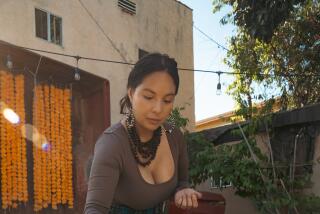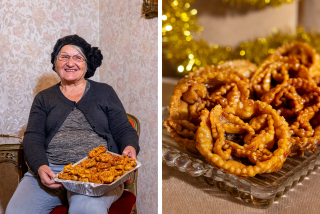Perugia for Chocoholics
- Share via
PERUGIA, Italy — Scaring up some Halloween fun in Italy, where the holiday is not celebrated, means settling for dubbed Wes Craven movies and a couple of Tronky chocolate bars. But last year we discovered that the American season of gorging on candy coincides with the annual chocolate festival in Perugia. It sounded like fun, even if it meant treats without tricks.
From our home in Rome, we checked the government agriturismo guide, a list (in Italian) of farmhouse inns, and made reservations at Podere I Sette, in the hamlet of Magione, about six miles east of Perugia. My husband, Jeff, and I thought a country weekend would be a good change for our city children, Aaron, 10, and Hannah, 8.
Innkeeper Olindo Sette and I exchanged faxes (the preferred booking method) in Italian, but as it turned out, he spoke English, a souvenir from the year he spent in Miami nearly two decades ago. These days, with his wife, Graziella, and twin daughters, he coaxes olive oil from 2,000 trees, honey from busy hives, milk from wandering sheep and smiles from the inn’s mostly Italian guests.
Podere I Sette--”Sette Farm”--has six guest suites in converted stone farm buildings--mini-apartments, really, with kitchenettes, although guests also may dine family style in the main farmhouse. The furnishings were rustic but comfortable--a pine master bedroom, bunk beds in the smaller bedroom, a black-and-white TV (and no telephone). But it felt bleak and chilly, just like the October outside. Deep fog and a light drizzle obscured any mountaintop view, but we did see a swimming pool, its tarp cover sagging under wet leaves.
We were a bit stiff from the 2 1/2-hour drive from Rome, but we were so eager to get to Perugia that we didn’t even mind the city’s suburban sprawl.
With a population of about 150,000, Perugia is an important commercial center and prides itself on its universities, cultural events and soccer team. Its real treasure is its medieval core, which sits on top of a craggy hill, as lively today as when Renaissance masters graced it 500 years ago.
Eurochocolate, as the festival is called, was in its fifth year when we were there. It’s a two-week immersion in the culture of chocolate, with exhibits, stage shows, culinary demonstrations and tastings. (This year, Oct. 16 to 24, the festival includes a fashion show of chocolate-colored frocks, a road rally in which clues are collected at chocolate shops along the way and a checkers tournament played with chocolate pieces.)
Our insulin was pumping as we envisioned solid hunks of sugary statuary, creamy chocolate flowing from fountains and maybe even dark kisses raining from the skies.
Well, there was rain.
The tourist-packed Chocotram chugged past us as we climbed from the parking lot at the base of the city’s hill (there was a long wait for the escalators). Festival information signs directed us to Piazza IV Novembre, home to the Palazzo dei Priori, an impressive expression of civic power in the 13th century and still the seat of local government. Off to the side is the Collegio del Cambio, its interior lavished with frescoes done in 1499-1507 by the master known as Perugino. On the other side of the palazzo is the plain-faced 15th century Duomo. And leading out of the piazza is Corso Vannucci, a long avenue that a guidebook calls one of Italy’s greatest people-watching streets. That day it was crammed with people watching for signs of chocolate giveaways.
A stop at the visitors center in the piazza got us a map and a festival events calendar as well as claustrophobia from the crush of festival-goers. Besides tastings, lectures and carvings, the brochure listed choco-golf, choco-theater, choc-opera and even cruises on a choco-lake. But not then, not that day at that time; in the Italian tradition, events were scheduled for morning and evening, and we had arrived at lunchtime.
Fortified by a cappuccino and a Baci, a “kiss” of nut-studded fondant, we sought out personal space and other treasures inside the dark cathedral. The prize possession here is not art but an agate relic that Perugians believe is the Virgin Mary’s wedding ring, kept locked inside 15 boxes like so many Russian dolls.
Back outside, people were carrying sacks full of chocolate and even licking chocolate ice cream cones despite the bone-damp weather.
We thought about trekking a few miles to the Chocohotel--later we learned it was just an ordinary hotel with a facade made up as a chocolate bar--but decided instead to step into the art museum across the piazza.
The Galleria Nazionale di Umbria on the third floor of the Palazzo dei Priori traces the art history of the Umbrian region through all its magnificent Madonnas, crucifixes, saints and altarpieces, from ancient to modern times. The high point is the collection of paintings by Perugino and Pinturicchio done in the late 15th century. But all around are lesser works, some appropriate to a Halloween mood. Our children were fascinated by canvases bearing creepy skulls and strange-looking babies. We wondered aloud why artists of that time depicted angels as sweet babies but painted babies that looked like Winston Churchill.
Outside on Corso Vannucci, the crowds were back from lunch, intent on the pursuit of chocolate. We elbowed past an antiques market where porcelain dolls, dusty books and clutches of fussy jewelry vied for another chance to be cherished. But we barely got close enough for a peek as the pressing throngs hurried us down alleys until we found ourselves on the way back to the parking lot.
So far, only a 50-calorie Baci had passed my lips; if I didn’t watch out, I might lose weight on this weekend.
Lago Trasimeno, only a 15-minute drive from Perugia, proved a perfect antidote to the crowds. It was eerily quiet in the early autumn dusk. We contemplated the unimaginable: On these shores in 217 BC, Hannibal slaughtered 16,000 Roman soldiers and buried them in mass graves.
Leaves crunched underfoot and the cool air filled our lungs as we watched lights come up around the foggy lake shore. It was time to get back to the farm for dinner.
Olindo sat at the head of the long wooden table while Graziella put the finishing touches on our meal in her restaurant-size kitchen. Fragrant wood burned in the corner hearth. Dinner was plain--bruschetta, roast beef, green beans and French fries. The kids enjoyed it. Another guest, a bearded man from Sorrento, asked us about Halloween. A little girl told us she had seen “Titanic” quattro times. The others smoked and kissed and laughed and lounged as if it were their own dining room.
After dinner, Olindo and the children heaped chestnuts into a long-handled iron skillet and took turns holding it over the fire. The sweet toasted meat charmed us, a simple treat worlds removed from the confectioner’s craft.
The next day we made a last-ditch effort to find chocolate. We went to the source, the Perugina factory in nearby San Sisto, where old-style factory tours promised enough chocolate to make us swoon. “But our factory is not open on Sundays,” said the hostess. “We are so mad at the festival for advertising it today.”
Well, we could have sued. Instead we bought a two-pound block of dark chocolate at the factory museum store and started chipping away at it before leaving the parking lot.
Less than nine miles from Perugia on the highway back to Rome is Deruta, a tiny town devoted to hand-painted majolica ceramics that are much admired throughout the world. The craft dates back to the height of Renaissance art in Umbria, when local artisans began combining Moorish designs and colors from Spain with the ancient Roman potters’ skill.
Every other store in Deruta was bursting with distinctively patterned blues and golds, with touches of reds and browns, in dinnerware, vases, umbrella stands and garden urns. Prices didn’t vary much--none were cheap--but workmanship and creativity did.
We weaved in and out from store to store, up and down the cobblestone hills. We settled on a vase and then headed on down the road to Todi, just another perfect Umbrian hill town. (This year Deruta joined the chocolate festival, inviting visitors to dip into a huge majolica cup filled with 600 pounds of chocolate ice cream.)
Todi has a striking medieval piazza, where the Duomo faces a 13th century palace fronted by a staircase of cinematic proportions.
We had worked up an appetite in Deruta, and Todi seemed promising as a lunch stop. Cafes skirted the piazza, but few people sat outdoors in the damp air. It was cozy inside Pizzerie Cavour, and we were happy with a pizza that sighed beneath heapings of prosciutto, anchovies and porcini mushrooms.
Halfway down the tree-lined road to the highway, we stopped at Santa Maria della Consolazione, an imposing example of pure Renaissance architecture. Across the piazza is a curving stone wall, beyond which lies a wide-angle view of the Umbrian countryside.
Red-faced bicyclists sat on stone benches nearby, eating sandwiches and soaking up the sumptuous scenery. Tired, we joined them to take in the view and finish our souvenir chocolate.
Strange weekend. The next day’s newspaper reported that the special chocolate sculpting demonstrations in Perugia were discontinued because too many impatient spectators were doing their own chiseling. Likely story. Probably the people of Perugia had had their fill.
(BEGIN TEXT OF INFOBOX / INFOGRAPHIC)
GUIDEBOOK
Sweet Italy
Getting there: There’s no nonstop service from Los Angeles to Rome. Alitalia, Delta and TWA have direct flights (one stop, no change of planes). Round-trip fares start at $660.
Perugia is a 2 1/2-hour drive north of Rome.
Getting around: The old city center sits atop a hill and is closed to most traffic. There is parking and escalators at the hill’s base.
The chocolate festival is Oct. 16-24 this year. For information: Internet https://www.chocolate.perugia.it.
Where to stay: Podere I Sette has kitchenettes. Price per person: $27-$39 for room only, $42-$48 with half board, $54-$60 with full board depending on season. Telephone/fax 011-39-075-840-9364, Internet https://www.isette.it.
For more information: Italian Government Tourist Board, 12400 Wilshire Blvd., Suite 550, L.A., CA 90025; tel. (310) 820-0098, Internet https://www.italiantourism.com.
More to Read
Sign up for The Wild
We’ll help you find the best places to hike, bike and run, as well as the perfect silent spots for meditation and yoga.
You may occasionally receive promotional content from the Los Angeles Times.






